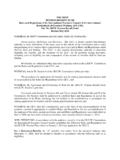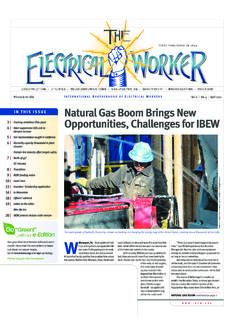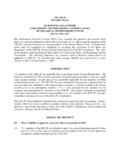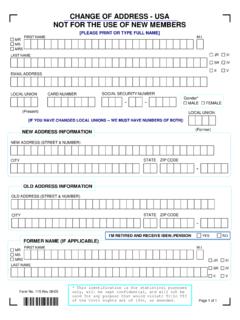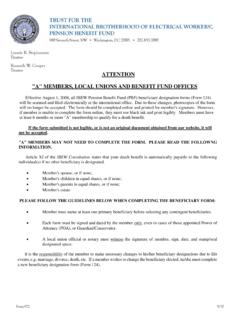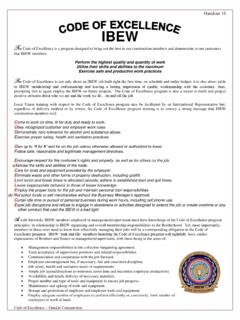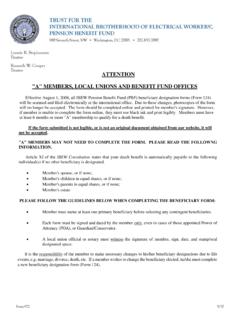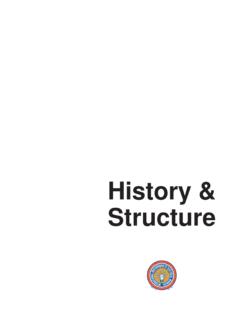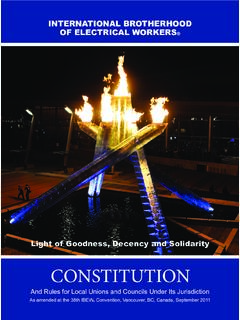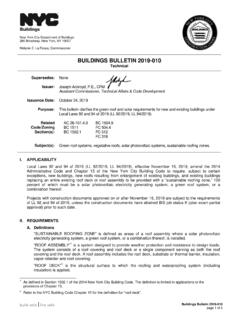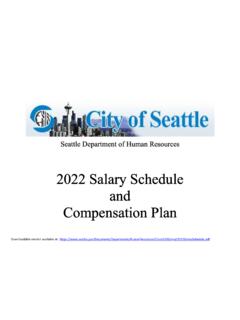Transcription of History & Structure - International Brotherhood of ...
1 History & StructureCelebrating 125 Years of IBEW ExcellenceThis is the story of the International Brotherhood of electrical Workers one of hard work, skill, and cour-age. Our organization s goal has remained steady since our beginning: to promote excellence in the electrical industry and improve our members lives. We hope that this story makes you proud of your union heritage and inspires you with the spirit of solidarity as we build the IBEW of the future. Th e IBEW Conventions that have shaped our union for more than a century serve as the framework for our his-tory. Th e fi rst part of History & Structure off ers a chrono-logical record of important IBEW historical events and insight into our organization s struggles and successes. Th e second part lays out how the IBEW is organized and explains our Structure , from how we make our laws to how the IBEW s local unions, districts, and International Offi ce work together to carry out the important work of the Brotherhood .
2 Much can be learned from the History of our Brotherhood , and lessons from our past continue to shape our actions today. We will never forget all the work done by our pre-decessors to build and grow this organization. Th eir fi ght for a standard of living proportionate to their skills and integrity continues to this President, IBEWH istory & StructureCelebrating 125 Years of IBEW ExcellenceContentsPart I: History of the IBEW Early Years: 1844 1896 3 Victory and Progress: 1897 1913 11 Growth, Depression, and Recovery: 1915 1940 15 World War II and the Modern Era: 1940 1998 21 IBEW in the 21st Century: 2000 2016 33 IBEW Conventions and Leaders 36 IBEW Per Capita Payments 37 IBEW Timeline 38 Part II: Structure of the IBEW Organization 45 Jurisdiction 49 Industries of the Brotherhood 51 Services of the International Offi ce 57 Part I1 Early Years2 Victory and Progress3 Growth, Depression, and Recovery4 World War II and the Modern Era5 IBEW in the 21st CenturyHistory of the IBEWTh e International Brotherhood of electrical Workers (IBEW) is the most established and extensive electrical union in the world, exist-ing as long as the commercial use of electric-ity.
3 From the beginning, workers realized the importance and danger of electricity. As the industry grew, electricians began organizing themselves and setting the stage for increased safety measures, fair pay, and a better standard of living. 1844 1880 THE DAWN OF ELECTRICITYTh e telegraph was the fi rst electrical accom-plishment of commercial importance, and it transformed the practical application of elec-tricity, which most people of the time believed to be an interesting but dangerous experiment. For the fi rst time, messages could be trans-mitted to people over great distances. In 1844, the fi rst telegraph wires were strung between Washington, DC, and Baltimore, Maryland, carrying the famous message of Samuel Morse, What hath God wrought? An Industry Is BornIn 1848, the fi rst telegraph station was built in Chicago, Illinois.
4 By 1861, a web of telegraph lines spanned the United States; and in 1866, the fi rst permanent telegraph cable was suc-cessfully laid across the Atlantic Ocean. Hiring linemen to string the new network of wires was a necessity, and young men across the land fl ocked eagerly to be a part of this new and exciting profession. Th e general public became increasingly aware of the possibilities of electricity when the telephone was introduced in 1876 and with Th omas Edison s invention of the fi rst suc-cessful incandescent lamp in 1879. Electricity began to transform American life. In 1882, the fi rst central power station was built in New York City. Known as the Pearl Street Generating Station, it was capable of lighting 85 buildings. As public demand for electricity increased, the number of electrical workers continued to grow.
5 Where once only a few intrepid linemen handled electricity, many now appeared on the scene, along with wiremen, seeking their life s work. Th is rapid expansion of the electric power and light industry kept demand for labor high. However, employers kept wages low by hiring an untrained workforce. Without proper training, the industry was overrun by individuals with inadequate skills and insuffi cient knowledge to practice the trade with proper regard for safety making an 1 Early Years: 1844 1896 Workers laying tubes for electric wires in the streets of New York City; illustration from Harper s Weekly, 1882 34 Early Years: 1844 1896already dangerous job more risky. Th e surge toward unionism was born out of the industry s deplorable safety conditions and workers demand for higher standards and Signs of UnityBeginning in 1870, many small electrical unions were organized, only to disappear shortly thereaft er.
6 By 1880, enough telegraph linemen had organized themselves to form a local assembly, which affi liated with the Knights of Labor, an important labor organi-zation of the day that was established in 1869. A few more local assemblies were organized, and a district council was formed. In 1883, this council called a strike against the Western Union telegraph company, demanding 8-hour workdays, an increase in pay, and equal pay for women. Th e strike failed aft er 1 month and broke up the fi rst known attempt to organize electrical the defeat, the desire for workers to unite remained strong. In 1884, a group of linemen formed an organization called the United Order of Linemen. Th e group was headquartered in Denver, Colorado, and was able to organize a considerable number of line-men in the Midwest and western United States. However, it was not until a few years later that our Brotherhood would be formed.
7 1890 THE BEGINNINGS OF BROTHERHOODIn 1890, the St. Louis Exposition, an annual agricultural and technical fair, featured electri-cal wonders of the era. Wiremen and linemen from all over the United States fl ocked to St. Louis, Missouri, the fourth largest city in the United States at the time, to wire the buildings and erect the e exposition workers got together at the end of each long workday and talked about the toil and conditions for those in the electrical indus-try. Th e story was the same everywhere: Th e work was hard, the hours were long, and the pay was spare. It was common for a lineman to risk his life on the high lines in all kinds of weather for 12 hours a day, 7 days a week. Two dollars and fi ft y cents a day was considered an excellent wage for wiremen, and many electri-cal workers were forced to accept work for just $8 a week.
8 However, skilled laborers in other trades earned more. By comparison, plumbers in large cities averaged a daily wage of $ and bricklayers and masons earned an average of $ per day. Another concern was that there was no train-ing, and safety standards were nonexistent. In some areas, the mortality rate for linemen was one out of every two hired, and the national mortality rate for electrical workers was twice the national average for all other Union FormsA union was the logical answer for the many problems facing these workers; so the small group of electricians meeting in St. Louis sought help from the American Federation of Labor (AFL) to unionize. An organizer named Charles Kassel was assigned to help them, and in 1890 the group was chartered as the electrical Wiremen and Lineman s Union, No. 5221, or the AFL Federal Labor Union 5221.
9 A St. Louis lineman, Henry Miller, was elected president. Henry Miller, founding father of the IBEW5 History & StructureIt was apparent to Miller and the other work-ers at the exposition that their small union was merely a starting point. Only a national organization of electrical workers with ju-risdiction covering the entire industry could win better treatment from the large corporate telephone, telegraph, electric power, elec-trical contracting, and electrical equipment manufacturing Leaders Set the PaceHenry Miller was a man of remarkable courage and energy. Kelly, the fi rst secretary of our Brotherhood , said of Miller, No man could have done more for our union in its fi rst years than he did. Miller packed his tools and an extra shirt in an old carpetbag and rode the rails to many cities to work the trade. Th e receiving committee for Miller s arrival in a city was oft en a railroad bull a policeman who chased him and tried to put him in jail for his unauthorized mode of travel.
10 Nonetheless, Miller persevered. Everywhere he went, he organized the electrical workers he met into local unions. Largely because of Miller s work, a great deal was accomplished in that fi rst year of the union. Local unions char-tered by the AFL and other electrical unions were organized all over the United States, including Chicago; Milwaukee, Wisconsin; Evansville and Indianapolis, Indiana; Louisville, Kentucky; New Orleans, Louisiana; Cincinnati and Toledo, Ohio; Philadelphia and Pittsburgh, Pennsylvania; Duluth, Minnesota; and New York FIRST CONVENTIONTh e First Convention was called in St. Louis on November 21, 1891. Ten delegates attended, representing 286 members: 1. Henry Miller, St. Louis2. Kelly, St. Louis3. W. Hedden, St. Louis4. Sutter, Duluth5. M. Dorsey, Milwaukee6. Finnell, Chicago7. E.
